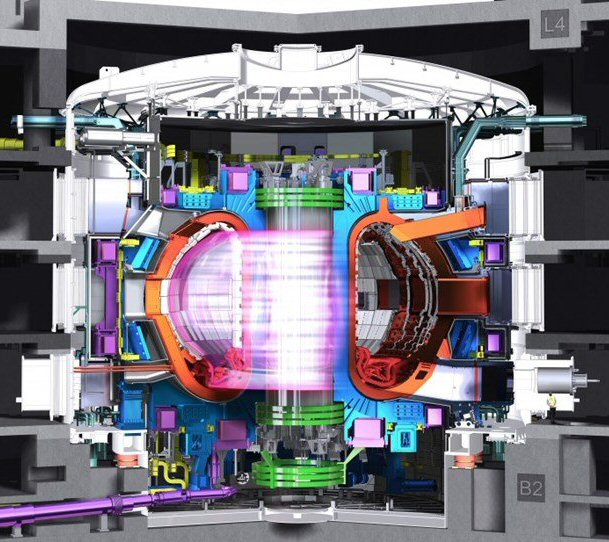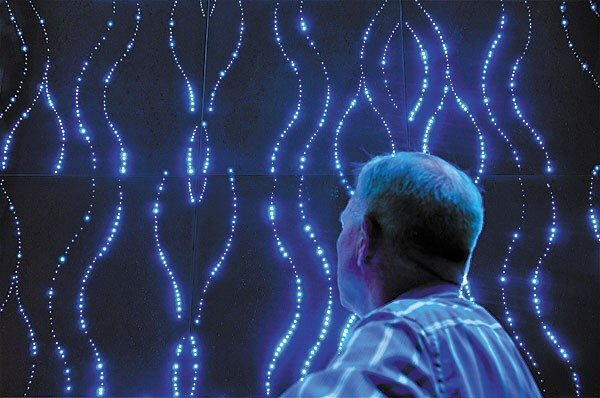
April 28, 2020
By Steven B. Krivit
Return to ITER Power Facts Main Page
SUMMARY
The proponents of ITER, the publicly funded International Thermonuclear Experimental Reactor, claim the device is the way to a future of virtually limitless carbon-free energy from nuclear fusion.
ITER is designed to accomplish a scientifically significant result, the production of particles from nuclear fusion that have a total of 500 million Watts of power. If it succeeds, that result will also show that the reactor can produce the same amount of overall power that it consumes. In other words, it would demonstrate a net overall reactor output of zero Watts. However, ITER was universally misunderstood by the public, news media, and government officials as an overall reactor system that would produce a potentially usable thermal power output of 500 million Watts. How did this misunderstanding happen?
BACKGROUND
The misunderstanding is the result of a long-standing pattern of poor communication by fusion representatives. It began at least by 1978, when Anne Davies, the chief of the Tokamak Systems Branch in the U.S. Department of Energy spoke with journalist Edward Edelson, writing for Popular Science, about the forthcoming Tokamak Fusion Test Reactor (TFTR) at the Princeton Plasma Physics Laboratory.
After she spoke with Edelson, he wrote that the overall TFTR reactor was designed to get out at least as much energy as was put into the reactor, and possibly more. With an output of fusion particles with 10 million Watts and an electrical input of 950 million Watts, nothing could have been further from truth. The mistake happened because Davies a) didn’t tell Edelson how much overall power the machine would require and b) she led him to believe that the overall input power was going to encompass only the thermal power used to heat the fuel. The fuel, forms of hydrogen called deuterium and tritium, when heated to millions of degrees, become a fusion plasma.
I spoke with Davies in 2018 and asked her about the error in the Popular Science article. (Link to interview) She said “I either assumed the reporter understood what I meant or I actually explained it and he left it out, perhaps to shorten the article.” Two other journalists, after speaking with Davies in 1992 and 2003, came away with the same misunderstanding.
In the 1990s, fusion representatives including Davies told members of Congress that state-of-the-art fusion reactors had produced millions of Watts of power, but only for a few seconds. The Congressional record shows that fusion representatives spoke about TFTR and, by their use of specific language and their omission of specific facts, created the impression that the TFTR reactor produced a net, rather than gross output of 10 million Watts from the fusion reactions. The practical limitation, they explained, was that the reactions lasted only a few seconds or minutes. During testimony, nobody explained that the 10 MW was, in fact, a gross output value. Nobody explained that TFTR was designed to consume 950 MW of electrical power.
The Congressional witnesses during that testimony spoke about ITER in the same way, creating the impression that the projected 500 megawatt output would be a net output value when, in fact, it is designed to be a gross output value. Nobody explained that ITER was designed to consume a minimum of 300 megawatts of electrical power.
Around 2007, fusion representatives shifted the ITER messaging slightly and began introducing an input power value. They began saying that according to the ITER design, the reactor would consume only 50 MW of power. But this was not true.
This pattern of poor communication by fusion representatives took place for four decades. For the last two decades, the promotions by the fusion representatives created the widespread false impression that the ITER reactor is designed to a) consume only 50 megawatts of power, b) produce 500 megawatts of power, c) demonstrate that a fusion reactor can produce 10 times the power it uses, and d) demonstrate that a fusion reactor can produce power equivalent to that of a small conventional power plant.
Soon after I uncovered and published the previously undisclosed power facts about the ITER reactor in my October 2017 investigation, fusion organizations around the world began, one by one, to make corrections to their public claims.
My sources were three independent fusion experts: Daniel Jassby, a former principal research physicist at the Princeton Plasma Physics Laboratory; Hartmut Zohm, the head of the Tokamak Scenario Development Division at the Max-Planck-Institute of Plasma Physics; and Steven Cowley, the current director of the Princeton Plasma Physics Laboratory and former chief executive officer of the United Kingdom Atomic Energy Authority.
After I published my investigation, Zohm told me about the Japanese JT-60SA project Web site which confirms that “ITER is about equivalent to a zero (net) power reactor.”(Archive copy)
Nick Holloway, the media manager for the U.K. Atomic Energy Authority and Culham Centre for Fusion Energy, later added this to the UKAEA Web site: “ITER should produce about as much fusion power as the electricity required to run the entire plant.” (Archive copy)
REAL PURPOSE OF ITER
The correct power values are defined in the 2002 International Atomic Energy Agency design specification for ITER. But when fusion representatives told people the objectives of ITER, they omitted essential details as well as their unique definition of “fusion power.”
The design specification for ITER provides a power value that applies only to the plasma. The value has nothing to do with the overall reactor power production or overall reactor power consumption. Until recently, fusion scientists did not explain this clearly to the public.
Until recently, fusion scientists also did not explain that the much-publicized input power value of 50 MW excluded the majority of input power required to operated the ITER reactor. Also, they had not disclosed that the 500 MW output power value did not account for the 300 megawatts that will be consumed by the reactor. Nor did they disclose that the reactor would briefly need 400 megawatts of electricity to start the reaction.
Additionally, the publicized input power value of 50 megawatts had been depicted incorrectly because fusion representatives had failed to make another key distinction publicly. According to the ITER design specification, the amount of thermal power that reaches the inside of the chamber to heat the fuel is designed to be 50 MW. (A few sources say that the injected thermal power will be slightly higher.) However, the amount of electrical power consumed to create that 50 MW heating power will be 150 MW, or even higher.
None of this had been communicated clearly by ITER representatives during the past two decades. Instead, as evidenced by nearly all examples, including reports from the most authoritative news sources, encyclopedias, European Union government documents, a White House press release, U.S. Congressional records, and documents published by ITER contractors for their investors, the international fusion community created the false impression that the ITER reactor should produce 10 times the power it consumes.
THREE ELEMENTS
The communication failure about the results of ITER’s predecessor, the Joint European Torus (JET) fusion reactor, and about the purpose and design of ITER comprised three primary elements:
1. Double Meaning of “Fusion Power”
Fusion experts did not tell people that there is a second meaning for the phrase “fusion power.” The first meaning, which most people did understand, is the amount of potentially usable (net) thermal power that would be produced by a fusion reactor. The second meaning of “fusion power,” which most people did not understand, is the gross thermal value of the particles produced in fusion reactions, irrespective of any input power.
2. Real Meaning of Input Power
Fusion experts did not explain that, when they normally discuss fusion reactor input power, they are referring only to thermal power injected into the plasma, not the required input power for the overall reactor, or even the required input power for the heating systems.
3. Hidden Overall Electrical Input Power
Fusion experts did not reveal the actual total input power required for each of the reactors. Before 2015, no Internet Web page disclosed the correct total power consumed by JET. Before 2019, only the Japanese fusion team’s Web site transparently stated the expected overall power balance for ITER.
THE EFFECTS
Collectively, these three communication elements caused non-experts to incorrectly believe that the total electrical input power consumed by JET was 24 MW and that the overall JET reactor made almost as much power as it consumed. In reality, the total electrical input power consumed by JET was 700 MW. JET lost 98% of the power it used. In many cases, the fusion community explicitly claimed that the total input power used to produce JET’s 16 MW result was only 24 MW. With the establishment, years ago, of the false perception that JET made almost as much overall power as it consumed, the claim that the ITER reactor could demonstrate a tenfold power gain seemed reasonable to the lay public.

REDDIT comment posted by user nhillson. Fusion proponents caused people who were not experts in fusion to believe that JET had produced 70% of the power it consumed and the proponents therefore created the reasonable expectation that ITER could produce ten times the power it would consume.

Fusion proponents caused attorneys writing for The National Law Review to believe that JET had produced 70% of the power it had consumed, producing fusion reactions with 16 MW of heat from 25 MW of electricity. It actually used 700 25 MW of electricity. After I contacted the authors, they did not respond. After I contacted NLR Managing Director Jennifer B. Schaller, she took the article down for a month and put it up later without the false JET claim. (Before) (During) (After)
Collectively, these three communication elements caused non-experts to incorrectly believe that the total input power for ITER is designed to be 50 MW and that the overall reactor is designed to make 500 MW, 10 times more power than it will consume. In many cases, the fusion community explicitly claimed that ITER would produce power on the same scale as a small working power station. In reality, if the ITER design succeeds, 300 MW of electricity will go into the overall reactor and the equivalent of 214 MW of electricity will come out of the overall reactor from the emitted neutrons, a loss of 86 MW.
TRANSPARENCY
I published the results of my investigation and the previously undisclosed power facts about the ITER reactor in October 2017. (See Timeline) A month later, the ITER organization corrected some of its false claims. Two months later, the organization issued a press release. Although it avoided claiming that the reactor would produce 500 MW of power, it claimed that ITER is a “project to prove that fusion power can be produced on a commercial scale.”
I contacted other leaders of the fusion research community, explained the results of their poor communications, and encouraged them to correct their Web sites. Many of them have made some corrections. All of them have declined to publish the second meaning of “fusion power.” Most of them have declined to publish the overall amount of power expected to be consumed by the reactor.
Leaders of fusion organizations I spoke with said that they were not ethically obligated to do so because ITER is not designed to produce overall net power. ITER, they said, is not designed to demonstrate that it is possible to produce commercial-scale energy from fusion. But those are precisely the two fundamental messages fusion representatives conveyed to the public and legislators in the past two decades that led to their support of the experiment and the expenditure of $20 billion of public money.
=============
Postscript:
MIT used the same three elements in their privately funded fusion project.






